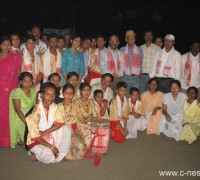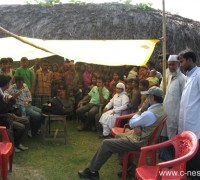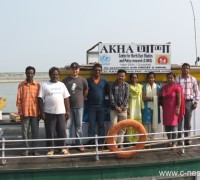The Ships of Hope
For centuries, the Brahmaputra river has swept along its long journey from Tibet to the Bay of Bengal, touching the lives of tens of millions with its enormous power, physically, culturally and economically. Every year, lakhs of people are displaced and extensive property, crops and livestock are destroyed in annual floods in Assam and other North-eastern states. Health problems are acute and government outreach remains inadequate.
Not less than 15 to 20 lakh people live in Assam on these chars or saporis, as they are called.
In an innovative effort to bring better health to communities in the valley, the Centre for North East Studies and Policy Research (C-NES) has designed and developed Akha – described also as “A ship of hope in a valley of flood” to provide mobile health services to the poor and the marginalized on the river islands in Dibrugarh district of Assam. The focus has been children as well as vulnerable adult groups.
My team and I developed the concept and today the project provides training and awareness on health, sanitation, livestock care and education in one of the most under-developed parts of the country.
The design won an award in the World Bank’s India Development Marketplace 2004 competition; judges said it represented a unique innovation that could transform the lives of rural communities. With the funds from that award, the ship took shape at Maijan ghat, Dibrugarh with carpenters from Dholla, Tinsukia, and under the supervision of Kamal Prasad Gurung, a local boat builder.
The boat, completed in June 2005, is 22 meters long and over 4 meters wide, has an OPD, cabins for medical staff, medicine chest, kitchen, toilets, crew quarters and a general store. Equipped with a generator set and a 200 liter water tank, it is powered by a 120 hp engine. And since it began service, it has reached about 5,000 persons, including a large number of children with immunization, through 13 camps, on a regular basis, or 25% of the island population in the areas where it is working.
We have partnered with UNICEF and the district administration and have focused on one area because we wanted to understand how well a prototype of this size could work. C-NES aims at making health care truly inclusive and accessible to all, especially those on the margins.
Today, we can say confidently that the Akha approach has worked and the process is relevant and can be replicated across the region and even abroad.
A Coordination Committee (CC) was set up for the smooth conduct of the health camps. The CC members comprise of representatives of the district administration, district health department, Assam Medical College and Hospital (AMC&H), Inland Water Transport Department, entrepreneurs, civil society groups, and representatives of C-NES. The Deputy Commissioner chairs the CC.
A number of groups, institutions, and companies including the Oil and Natural Gas Commission Ltd., the office of the Additional Joint Director of Health (Family Welfare), Government of Assam, Rastriya Gramin Vikash Nidhi (RGVN), Jalan Industries Ltd., Oil India Ltd. and Indian Oil cooperation (Assam Oil Division) have supported the project.
In addition to human health care, we have introduced a new element – of taking veterinarians to the islands where large cattle populations live because these habitations are one of the primary centres of milk production in Assam, but like their owners, have no access to health treatment.
For the first time in their history, the livestock of these communities are benefiting from trained veterinarian assistance and are also being trained as para vets. It becomes an income earner and alternative livelihood: they can provide basic treatment not only to their own cattle but, for a modest fee, to other villagers.
In all these efforts, the role of the district administration of Dibrugarh has been central, critical and extremely sensitive and supportive.
This is the Akha model: initiatives, innovativeness, motivation, mobilization, training, self-help and sustainability, giving all a stake in improving their lives, not just relying on governments and other agencies.
The new ship, SB Shahnaz, which is being commissioned – and funded by Swaminathan S. Aiyar, the prominent editor and thinker – will operate in two other districts, Tinsukia and Dhemaji, extending the embrace of health care and other services to more vulnerable groups.
This is part of the process of innovation and change, strongly rooted in reality and local stakeholders, that must now sweep across the Brahmaputra Valley and beyond if the region is to grow in prosperity and stability.


